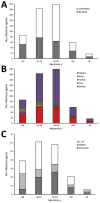Enteric Infections Circulating during Hajj Seasons, 2011-2013
- PMID: 28930004
- PMCID: PMC5621540
- DOI: 10.3201/eid2310.161642
Enteric Infections Circulating during Hajj Seasons, 2011-2013
Abstract
Hajj, the annual Muslim pilgrimage to Mecca, Saudi Arabia, is a unique mass gathering event that raises public health concerns in the host country and globally. Although gastroenteritis and diarrhea are common among Hajj pilgrims, the microbial etiologies of these infections are unknown. We collected 544 fecal samples from pilgrims with medically attended diarrheal illness from 40 countries during the 2011-2013 Hajj seasons and screened the samples for 16 pathogens commonly associated with diarrheal infections. Bacteria were the main agents detected, in 82.9% of the 228 positive samples, followed by viral (6.1%) and parasitic (5.3%) agents. Salmonella spp., Shigella/enteroinvasive Escherichia coli, and enterotoxigenic E. coli were the main pathogens associated with severe symptoms. We identified genes associated with resistance to third-generation cephalosporins ≈40% of Salmonella- and E. coli-positive samples. Hajj-associated foodborne infections pose a major public health risk through the emergence and transmission of antimicrobial drug-resistant bacteria.
Keywords: Hajj; Saudi Arabia; antimicrobial resistance; bacteria; diarrhea; enteric infections; mass gathering; viruses.
Figures

References
-
- GBD 2013 Mortality and Causes of Death Collaborators. Global, regional, and national age-sex specific all-cause and cause-specific mortality for 240 causes of death, 1990-2013: a systematic analysis for the Global Burden of Disease Study 2013. Lancet. 2015;385:117–71. 10.1016/S0140-6736(14)61682-2 - DOI - PMC - PubMed
MeSH terms
LinkOut - more resources
Full Text Sources
Other Literature Sources
Medical
Miscellaneous

